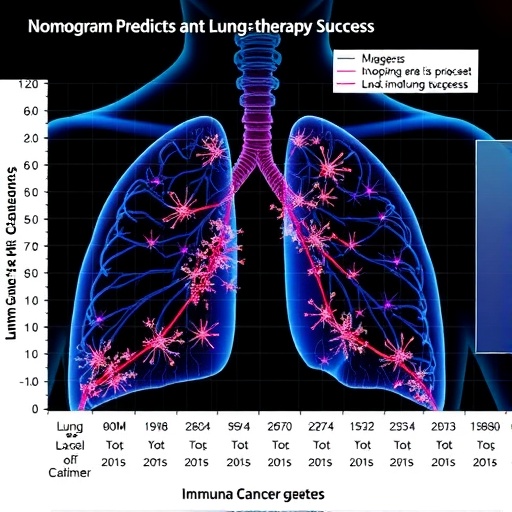Immunotherapy has revolutionized the treatment landscape for lung cancer, yet predicting which patients will benefit from immune checkpoint inhibitors (ICIs) remains a critical challenge. A groundbreaking study published in BMC Cancer unveils a novel nomogram integrating clinical and blood biomarkers to accurately forecast immunotherapy outcomes in lung cancer patients. This advanced predictive tool promises to enhance personalized treatment strategies and optimize clinical decision-making.
Lung cancer, the predominant cause of cancer-related deaths worldwide, continues to pose significant therapeutic challenges despite advancements in targeted therapies and immunotherapy. Immune checkpoint inhibitors have demonstrated remarkable efficacy in subsets of patients, markedly improving survival rates. However, response rates vary widely, and adverse effects can be debilitating, necessitating refined prognostic models to select ideal candidates for such treatments.
Researchers conducted a comprehensive retrospective analysis involving 436 lung cancer patients treated with ICIs. These patients were randomly divided into training and validation cohorts to rigorously develop and test the predictive accuracy of the nomogram. The study harnessed sophisticated statistical methods including LASSO regression and multivariate Cox regression to distill critical prognostic factors among a plethora of clinical and hematologic variables.
Key independent predictors emerging from the analysis encompassed the neutrophil-to-lymphocyte ratio (NLR), a marker reflecting systemic inflammation and immune status, as well as previous surgical history, liver metastasis, clinical staging, the number of treatment lines administered, and the patient’s response evaluation. These variables collectively informed the construction of a dynamic nomogram capable of individualized risk stratification.
Performance metrics underscored the nomogram’s robustness, with concordance index (C-index) values reaching 0.709 for overall survival (OS) and 0.730 for progression-free survival (PFS) in the training set. Validation cohorts showed commendable predictive consistency with C-indexes of 0.655 and 0.694 for OS and PFS respectively. Receiver operating characteristic (ROC) curves further confirmed the model’s accuracy in anticipating outcomes at 12, 24, and 36 months post-therapy.
The integration of the NLR is notably impactful as this ratio encapsulates the host’s inflammatory milieu, chiefly driving tumor progression and immune escape mechanisms. Elevated neutrophils may promote a suppressive environment, while diminished lymphocyte counts indicate compromised antitumor immunity, jointly forecasting poorer prognosis. By embedding such biomarker insights, the nomogram transcends conventional staging systems.
Moreover, previous surgery and presence of liver metastasis emerged as significant clinical determinants. Surgical intervention may influence immune landscape and tumor burden, whereas liver metastases often signify aggressive disease and immune microenvironment alterations, collectively dictating therapeutic responsiveness. These insights highlight the necessity of holistic patient assessment beyond tumor-centric parameters.
The model also incorporates treatment-related variables including prior therapy lines and clinical response evaluations, reflecting the dynamic interplay between tumor biology and therapeutic pressures. This adaptability ensures the nomogram remains pertinent across varied clinical scenarios and heterogeneous patient populations undergoing ICIs.
Calibration curves demonstrated strong agreement between predicted and actual survival probabilities, bolstering confidence in the nomogram’s real-world applicability. Decision curve analysis (DCA) further verified its clinical utility by illustrating net benefits across diverse threshold probabilities, essential for guiding therapy choices and resource allocation.
Kaplan–Meier survival analysis substantiated the model’s stratification capabilities, effectively delineating high-risk patients who exhibited significantly shorter median OS and PFS with statistical robustness (P < 0.001). This stratification paradigm equips clinicians with a potent tool for identifying patients who might require intensified monitoring, combination therapies, or alternative regimens.
The study underscores the cost-effectiveness and accessibility of incorporating routine blood parameters alongside clinical data, a strategic advantage for widespread implementation. By eschewing reliance on expensive genomic profiling, this nomogram enhances feasibility in diverse healthcare settings, including resource-constrained environments.
This innovative approach heralds a pivotal advance in precision oncology for lung cancer immunotherapy. It empowers oncologists to tailor treatment pathways more judiciously, potentially improving survival outcomes while minimizing unnecessary toxicity from ineffective therapies. The integration of systemic inflammatory markers with clinical characteristics represents a forward leap in nuanced patient profiling.
Future research could expand upon this model by integrating emerging biomarkers such as circulating tumor DNA, tumor mutation burden, or immune profiling, potentially refining predictive capabilities further. Prospective validation in multi-center cohorts and diverse ethnic populations will be essential to confirm its generalizability and optimize its clinical deployment.
Patients facing lung cancer treatment now have hope for more personalized therapeutic journeys guided by predictive analytics rooted in biological and clinical realities. The synergy between data-driven models and clinical acumen is reshaping oncology paradigms and fostering more informed, effective treatment strategies.
In summary, this newly developed and validated nomogram stands as a beacon of innovation combining simplicity, affordability, and accuracy. It marks an important step towards precision medicine in lung cancer, enabling more precise prognostication and individualized immunotherapy protocols that hold promise for improved patient outcomes worldwide.
Subject of Research: Development and validation of predictive nomograms for immunotherapy outcomes in lung cancer patients using integrated clinical factors and blood biomarkers.
Article Title: Development and validation of a nomogram for predicting immunotherapy outcomes in lung cancer patients using clinical and blood biomarkers
Article References:
Ouyang, T., Zhang, F., Yang, Y. et al. Development and validation of a nomogram for predicting immunotherapy outcomes in lung cancer patients using clinical and blood biomarkers. BMC Cancer 25, 1353 (2025). https://doi.org/10.1186/s12885-025-14559-1
Image Credits: Scienmag.com




